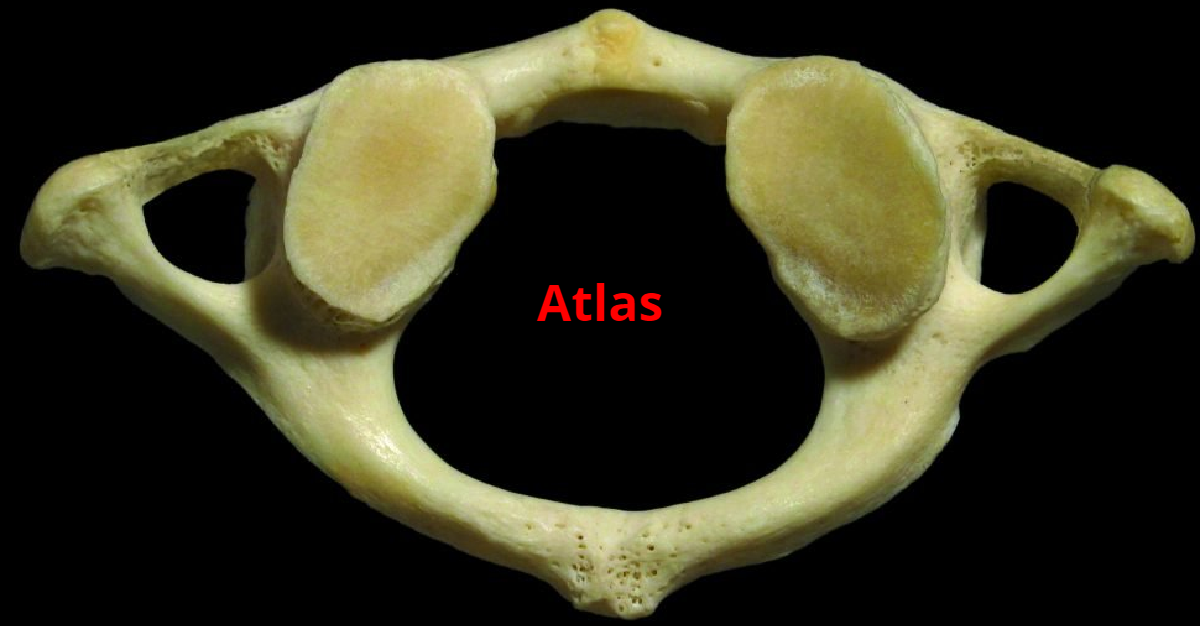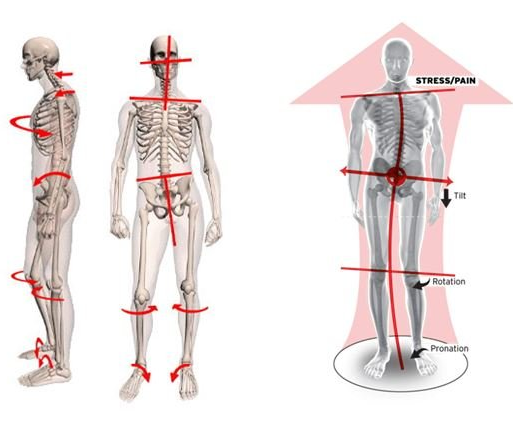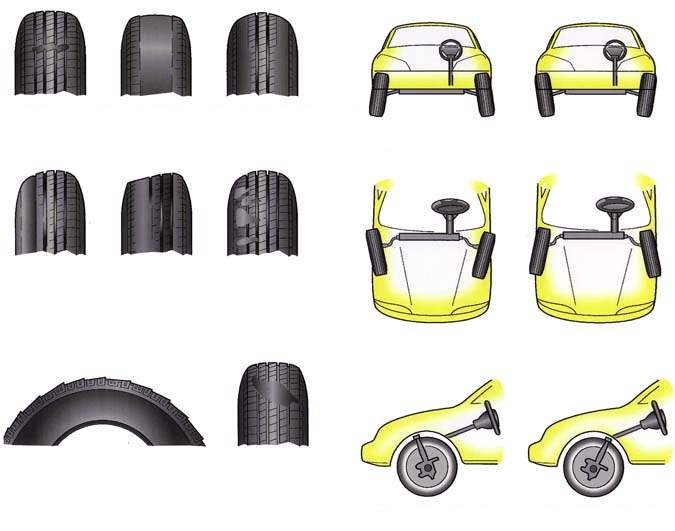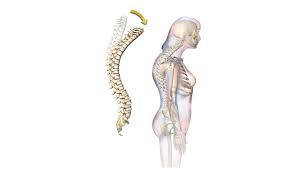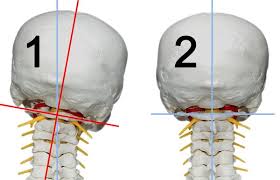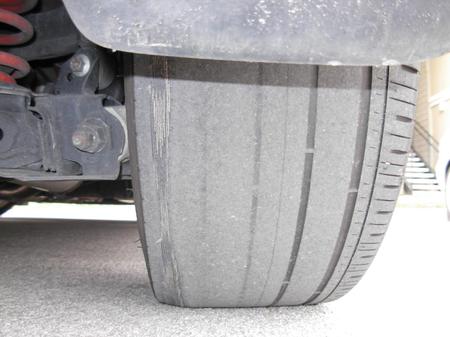Make knowledge with the weakest link in your body, the Atlas
The Atlas, your first half-vertebra also called C1
The Atlas is the first vertebra of our neck and is located directly below the skull. (see photo) Due to the vertical position of the human body, the Atlas makes a very close connection with the skull. This connection is detrimental to our vertical posture. The disadvantageous alignment is only noticeable in humans and is a major problem for overall health and thus for humanity.
A bone that only weighs 50-60 grams and wears our head was never meant for our vertical position! The Atlas is an annular cervical vertebra without a corpus, so that this vertebra is "hollow" on the inside. Instead of an upper joint protrusion, there are two joint surfaces that form hinged joints with the occipital nodules.
The Atlas has no joint of its own and therefore we cannot really say that the Atlas is dislocated when it is out of its ideal anatomical position. Suppose we would say it because we are not doctors, then you could say that someone has a migraine due to a dislocated Atlas vertebra.
When we nod YES, the skull and the Atlas move apart, and that is the only time they don't move together as a couple.
When we shake NO, the skull and the Atlas are one whole and move together around the 2nd cervical vertebra (Dens van Axis).
The remaining cervical vertebrae are also involved in all other movements and rotations of our head.
The Atlas vertebra is the only bone in our body that is repaired for life and, for example, does not suffer from descaling (osteoporosis), which happens with the rest of our bones.
Continue with subluxation from Atlas
Why does this bone deserve your attention?
The Atlas is a bone that, like all other bones, has its own function. Its function is to balance our head, nod YES and move with it when we move our head. However, this is not the reason why this bone is so important.
The position of this bone is very special and very important.
The position in daily life determines power, strength and responsibility. If this bone has not received any attention, not even the attention it deserves in medical books, how can we know anything about this bone?
How can we know of his wrong unfavorable alignment and recognize its symptoms? How can we know that a tilt of the Atlas has a huge impact on our entire body and life?
It is unimaginable and hard to comprehend.
So unimaginable that even very experienced radiologists, who see this bone daily and notice the tilt and shifts, do not realize its importance.
Before we continue, we will do a small test to get a good picture of our posture.
Stand up and relax your body. Take an attitude that feels comfortable and look at yourself in the mirror, or have someone look at you and take pictures!
The example on the right is a bit more extreme. The figure is quite skewed in order to give a better picture of what we should pay attention to. For some, however, this example may also be the reality.
Test your body
Are your eyes and shoulders in the
same
horizontal line?
A 100% spirit level parallel line ??
Or is one of your shoulders slightly
lower
than the other?
If your body shows a stress attitude, you are very welcome! Come for a free Atlas check
Awareness of your body posture is crucial!
Perhaps you have just noticed your skewed posture.
Or maybe you already know that your body is not 100% straight, but you could not help it or you thought that this posture is normal and that is why you did nothing about it.
For a vertical structure such as the structure of our body, standing 100% vertically is an unnatural and unhealthy position. To be in equilibration and balance, a vertical structure must also be vertically straight due to the influence of gravity.
If this is not the case, any vertical building would be a tower of Pisa that fights against gravity.
Because buildings have a hard structure (concrete piles) and a foundation, but our bodies have neither, we cannot compare ourselves to the tower of Pisa. As humans, we must fight gravity in a different way.
Insoles and muscle exercises, methods that have often been advised in recent years, do not work. This is because we have no foundation and hard structure in contrast to buildings, but the opposite.
Body posture is 100% dependent on the Atlas position, because the weight of the head must be balanced!
Function of the Atlas
As we know, the function of the Atlas is to hold our head straight to our neck and help dance if we wish to do so. The Atlas was given this task before we, as homo-sapiens, put on the bad shoes and from now on went after our food vertically.
Fortunately, since then our heads have become smaller through evolution, but our Atlas has unfortunately not grown. Because the Atlas remains far too small compared to our head and our spine is too flexible, balancing with the head has become unimaginably heavy for the Atlas since we have existed vertically.
We all know how hard it is to bring a full cup of coffee from a kitchen to the living room without spilling. Imagine that the cup is not in its ideal position on the saucer, but is shifted or tilted a few millimeters forward or to the right or to the left or right.
Had you tried at all to reach your living room in this way?
Would you accept that challenge with your expensive carpet?
How careful and balanced should your hand and the rest of your body be to do this job? Even your toes would get muscle aches from the effort to maintain your balance and balance.
The task of the Atlas is therefore super heavy and we certainly do not help with our habits. We often make the Atlas even more difficult.
What is actually sub-luxation of the Atlas
Sub-luxation of the Atlas is best compared to a misaligned wheel of your car. You can balance your tires time and time again, but your car keeps pulling left or right and the tires heat up and wear out!
You can then continue to replace the tires or simply align your wheels!
A classic feature of a poorly aligned Atlas!
Sub-luxation of the Atlas
You would think that a subluxation of Atlas is impossible because of the close connection with the skull, but unfortunately.
It is suspected that the Atlas is still formed in the wrong direction during pregnancy, due to the (sleeping) position of the fetus. The Atlas would then be shifted (backwards and to the right), tilted (to the right, to the left, upwards) and rotated (backwards to the right, forward to the left).
As a result, this close connection does not remain strong enough. This anatomical error is partly dependent on the pelvic position of the mother at that time.
Anyway, there are scientific indications that 98% of people are born (or during birth) with the Atlas outside of their anatomical position. The Atlas may have moved out of its position in various ways, just like the coffee cup from the ring of its saucer. This shift mainly depends on his former position and the trauma that sets him in motion. Just like a Whiplash.
Because the Atlas is not in its correct position in advance, the Atlas is easy to get moving. Shifts and tilting or incorrect rotation impede surrounding colleagues / neighbors vertebrae, muscles and nerves. An atlas block can also occur.
Atlas blocking often gives rise to half-sided headache complaints with pain from the back of the head radiating to behind the eye.
If you look at the illustration above, you immediately see that due to Atlas sub-luxation, smooth dancing with our head is not a problem-free action!
Very obvious to know:
In the case of the Atlas, neighboring neighbors, including blood veins, vertebrae, brain-stem, ligaments and muscles are obstructed and become irritated and pinched. They have more problems with this than the Atlas itself.
When we take this as a starting idea, we also understand the rest of what is happening in our body better.
Do a free Atlas-check
and discover whether your complaints can be resolved quickly and easily!
Free and non-binding MOT check!
We do the check of your body and we check whether your Atlas is properly aligned, because you are not driving your car with an incorrect wheel alignment either.
There is no good reason to do it with your most important possession!
Do a free Atlas check and check your alignment!
NB The information collected on this site is purely for information purposes. In no case and under no circumstances do we want to exclude or replace medical or healthcare



